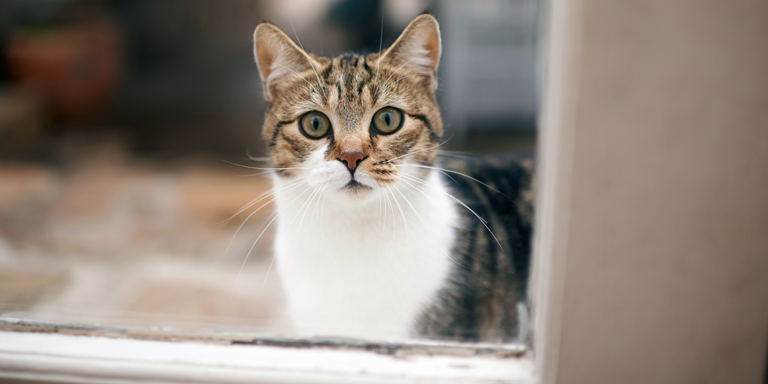Animal hair allergy
Formerly mainly farm animals, pets are now often treated as family members. However, close contact with them can also promote allergies.

Table of contents:
Animal hair allergies, especially to cat and dog hair, are common and can cause symptoms all year round.
Trigger
In principle, any animal with hair or feathers can trigger an allergy in humans. However, pets, especially cats and dogs, pose a particular risk, as they are especially close to humans. Other animal species known to trigger allergies are guinea pigs, hamsters, rabbits, mice, rats, horses, cattle and birds.
Contrary to popular assumption, most animal allergens are not found in the hair, but in proteins on the skin and in the saliva, urine and tears. When licking, the animal spreads these substances on its fur, hence the term "animal hair allergy". Animal hair allergies are classed as respiratory allergies.
The allergens bind to dust particles and, depending on their size, can float in the air for hours, where they can be inhaled before settling on the ground. They adhere to hair, clothing and fabrics, making it easy for them to spread and even reach places without any animals. This is why high allergen levels can often be detected in classrooms, hotel rooms, cinemas or on public transport. Even after an animal has gone, allergens remain in the home for a long time after, meaning that sensitive individuals can develop allergic reactions even without direct contact with animals.
All cats and dogs release allergens, regardless of age, gender, breed or hair length. There is no such thing as a hypoallergenic cat or hypoallergenic dog. However, the amount of allergens released varies greatly from animal to animal. In cats, hormone status plays a role: neutered males and females produce fewer allergens than unneutered males.
Symptoms
An animal hair allergy usually occurs immediately after contact with the trigger. The most common symptoms (sneezing, red and itchy eyes, runny nose) are typical of allergic rhinitis. Asthma attacks and, in rare cases, allergic shock can also occur. As this allergy, unlike a pollen allergy, can occur all year round, it is easily mistaken for a cold. Anyone who frequently has long-lasting or recurring colds should have a test carried out to rule out a possible animal hair allergy.
Diagnosis
If you experience symptoms that indicate an allergy, you should consult a doctor or allergist (allergy specialist). Various tests are available for diagnosis. After a detailed discussion about your medical history, skin and/or blood tests are usually carried out.
Treatment
The most effective way to alleviate the symptoms of an animal hair allergy is to avoid the allergens. It is best to give up the pets in question and clean the home thoroughly once they are gone. This also helps prevent chronic symptoms and reduce the risk of allergic asthma. Should giving up the pet not be an option, there are various measures to reduce allergen exposure (see tips and tricks). In addition, medication such as antihistamines or corticosteroid products can alleviate symptoms in the short term, e.g. when staying in hotels or visiting people with pets.
More information on the treatment of respiratory allergies
If moderate to severe symptoms persist despite all measures and medication, allergen-specific immunotherapy (desensitisation) may be considered, especially in the case of a cat allergy.
However, the data on the effectiveness of this treatment is still limited and the risk of unwanted side effects is higher than with other allergen-specific immunotherapies, e.g. for pollen allergies. Desensitisation is therefore only an option in certain cases and is currently not a treatment option for the majority of those affected.
Further information on allergen-specific immunotherapy
Tips and tricks
Should giving up the animal not be an option, various measures should be strictly followed in combination to reduce allergen exposure. If the symptoms persist, the option of giving up the pet should be reconsidered.
- Restrict the animal's access to the home or keep the animal outside where possible
- Ban the animal from the bedroom
- Wash the animal regularly with suitable care products
- Do not let the animal lick you and wash your hands after each contact
- Clean clothes regularly with a clothes roll (do not use a clothes brush), change and wash them after contact with the animal
- Leave the cleaning of the sleeping area and food bowls as well as the care of the animal to other, non-allergic individuals. Brush animals outside the home
- Use washable covers or throwovers for armchairs and cushions
- Remove carpets and all forms of dust catcher (curtains, soft toys, etc.)
- Wet mop the floors daily
- Vacuum regularly using a machine with a HEPA filter
- Use an air purifier with a HEPA filter: When shopping, look out for products with the allergy seal of approval; these are particularly suitable for people with allergies and intolerances and are recommended by aha! Swiss Allergy Centre.
Facts and figures
The number of people currently sensitised to animal hair varies depending on the region and population group. For Switzerland, current data shows that around 4% of the population is sensitised to cats and around 3% to dogs. It is not known exactly how many people actually suffer from an animal hair allergy, i.e. show corresponding symptoms.
Studies have investigated the effect of childhood contact to pets on the development of allergies and asthma, but with conflicting results. It is currently recommended that "at-risk families" (with a case/cases of atopic eczema or allergies to pollen, house dust mites or food) should not acquire a cat. There are no clear recommendations for dogs or other animals.
If you have asthma, even non-allergic asthma, it is generally inadvisable to get a hairy or feathered pet. In general, pets bring more dirt and dust into the home, which can lead to additional airway irritation and worsen symptoms in sufferers.
Editors: aha! Swiss Allergy Centre in co-operation with the Scientific Advisory Board.
Final revision of the website content: 26.11.2024



